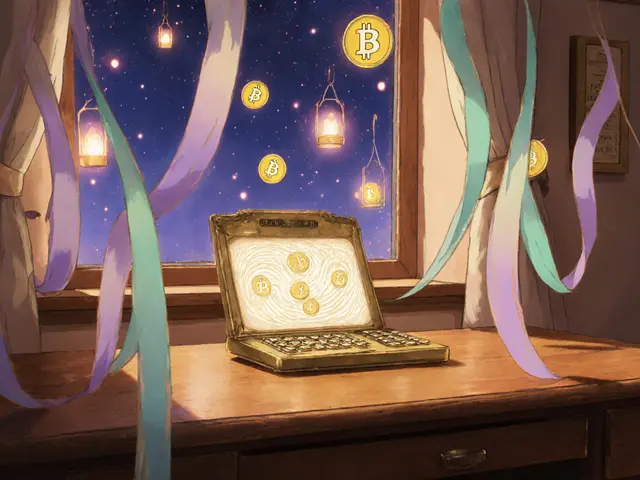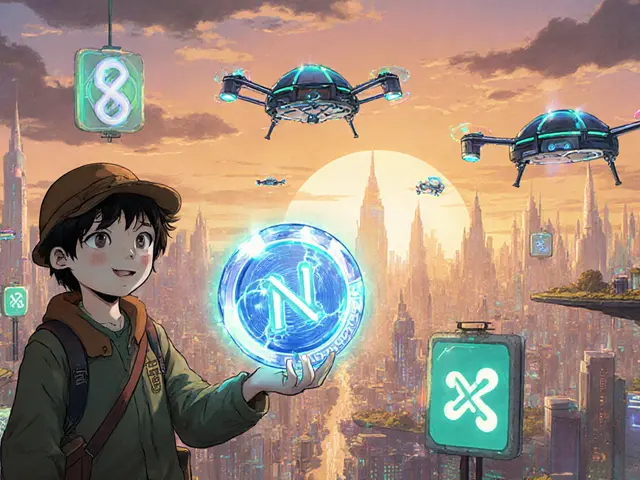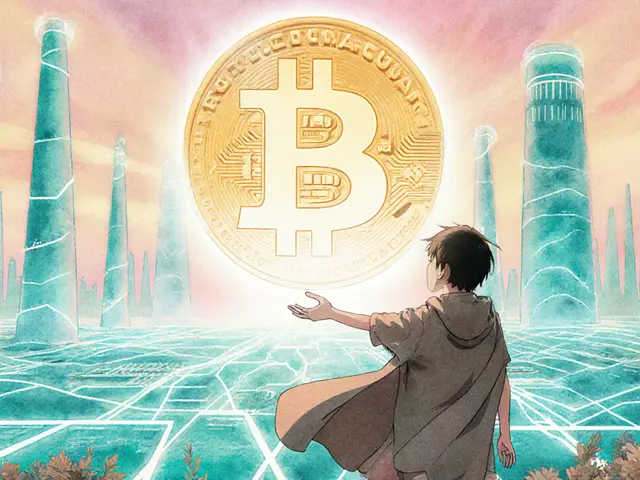30
How Fractional Real Estate NFTs Let You Invest in Property for Less

Fractional Real Estate NFT Investment Calculator
Investment Summary
Enter values and click "Calculate Potential Returns" to see detailed results.
Quick Summary
- Fractional Real Estate NFTs split a property into tradable digital shares.
- Investors can start with as little as $50,000 instead of buying whole buildings.
- Liquidity comes from secondary NFT marketplaces, not traditional real‑estate sales.
- Key risks include regulatory uncertainty and shared‑ownership governance.
- Getting started means setting up a crypto wallet, picking a compliant platform, and doing property due‑diligence.
What Are Fractional Real Estate NFTs?
Fractional Real Estate NFTs are digital tokens that represent a slice of a physical property. Each slice is a unique claim recorded on a public ledger, so ownership is transparent and tamper‑proof. Unlike regular cryptocurrencies, which are interchangeable, these tokens are non‑fungible, meaning they can tie back to a specific address, floor plan, or usage right.
The idea grew out of two older concepts: real‑world asset tokenization and the boom of non‑fungible tokens in art and collectibles. By locking a traditional property deed into a smart contract, developers can issue a fixed number of shares-often as ERC‑20 tokens-that are bought, sold, and transferred just like any other cryptocurrency.
How the Fractionalization Process Works
First, the property is minted as an NFT (usually following the ERC‑721 standard). This NFT holds the legal metadata: address, title number, appraisal value, and any usage‑right agreements.
Next, a smart contract Smart Contract locks the original NFT and creates a set of fungible ERC‑20 tokens. Each ERC‑20 token represents a fraction-say 0.01%-of the underlying property.
Investors purchase ERC‑20 tokens through a compliant marketplace. When enough tokens are collected to represent 100% ownership, the contract issues a “redeem” clause that allows the token holders to collectively trigger a sale or transfer of the deed.
Platforms like the Hedera Token Service lower transaction fees and provide fast finality, making the process affordable even for small investors.

Benefits Compared to Traditional Real‑Estate Investment
| Aspect | Fractional Real Estate NFTs | Traditional Ownership |
|---|---|---|
| Entry Capital | As low as $50,000 | Often $500,000‑$2M+ |
| Liquidity | Secondary markets, seconds to minutes | Months to years |
| Ownership Record | Blockchain‑based, tamper‑proof | County records, slower updates |
| Management | Professional services included on most platforms | Owner‑managed or hired property manager |
| Regulatory Clarity | Emerging, varies by jurisdiction | Well‑established legal framework |
Lower capital requirements open the market to a broader pool of retail investors. The blockchain record removes many of the paperwork headaches that come with title searches and deed transfers. And because each share can be sold on a digital exchange, investors can rebalance their portfolios without waiting for a buyer for an entire building.
Risks & Challenges You Should Know
fractional real estate NFTs sound attractive, but they’re not risk‑free. The biggest hurdle today is regulatory uncertainty. While the UAE has issued clear guidelines encouraging real‑world asset tokenization, many other countries still treat these tokens as securities, subject to capital‑markets law.
Shared decision‑making can also cause friction. When a major repair or a sale is needed, all token holders must agree or follow a pre‑programmed voting rule. Misaligned incentives may delay actions or create legal disputes.
Finally, the secondary market depth varies. Some high‑profile properties trade daily, while niche assets may sit idle for weeks, making exit timing less predictable than a traditional sale.
Getting Started - A Step‑by‑Step Guide
- Set up a crypto wallet that supports ERC‑20 and ERC‑721 tokens (e.g., MetaMask or a hardware wallet).
- Buy a small amount of a stablecoin (USDC, USDT) to cover purchase and gas fees.
- Choose a reputable fractional platform - look for KYC, audited smart contracts, and a clear legal framework.
- Conduct due‑diligence on the underlying property: location, rental yield, management team, and any usage‑right restrictions noted in the NFT metadata.
- Purchase the desired number of ERC‑20 tokens. The platform will lock them in a smart contract that records your ownership percentage.
- Monitor the investment through the platform’s dashboard. Most services provide automated rent distribution and expense reporting.
- If you need liquidity, list your tokens on an approved secondary marketplace. Follow the platform’s resale rules and confirm any lock‑up periods.
The learning curve is realistic: investors already comfortable with either real estate or blockchain can usually get up to speed in 2-4 weeks, while complete newcomers may need 2-3 months of reading and practice.
Market Landscape & Outlook (2024‑2026)
The fractional real‑estate sector hit $624million in 2022, driven by demand in the United States, Canada, Mexico, and the Caribbean. By March2025, the UAE led a global tokenization boom, attracting banks and property firms that see blockchain as a way to tap retail capital.
Analysts predict the market could surpass $1billion by 2026, especially as more jurisdictions publish clear token‑security regulations. Institutional players are testing pilot projects, and major custodians are adding real‑world asset NFTs to their offerings.
The biggest growth drivers will be:
- Regulatory clarity in Europe and North America.
- Improved platform UX that simplifies contract terms for non‑technical investors.
- Integration of property‑management AI that automates maintenance decisions across dozens of fractional owners.
If these trends hold, fractional NFTs could become a mainstream entry point for anyone who wants exposure to premium real‑estate without committing a mortgage‑size capital.

Frequently Asked Questions
Do I get a legal title when I buy a fractional NFT?
Most platforms issue a “beneficial ownership” claim recorded on‑chain, while the legal title remains with a custodial entity that holds the deed. The custodial agreement is usually vetted by local lawyers, but you don’t receive a physical title deed yourself.
Can I earn rental income from my tokens?
Yes. Platforms typically distribute net rental revenue proportionally to token holders each month. The payout is sent automatically in the stablecoin you chose during purchase.
What happens if the smart contract is hacked?
Reputable platforms run audited contracts and store the underlying property in a multi‑sig custodial wallet. If a breach occurs, the insured fund or the custodial entity can step in to protect investors, but you should always verify audit reports before committing funds.
How are taxes handled on fractional NFT gains?
Tax treatment varies by country. In the UK, for example, gains are generally subject to Capital Gains Tax, while rental income may be taxed as ordinary income. Always consult a tax professional familiar with crypto‑asset reporting.
Is there a minimum holding period?
Some platforms impose a 30‑day lock‑up to prevent rapid flip‑selling, while others let you trade instantly. Check the specific terms of the fractional offering you join.









celester Johnson
November 30, 2024 AT 08:58When the seductive promise of tokenized bricks meets the cold logic of blockchain, we witness a modern alchemy that feels almost religious. The notion that a $50 k stake could tether you to a skyscraper in Manhattan is intoxicating, yet it whispers of a deeper longing for ownership without responsibility. One might argue that this fractional veil masks the very real debts and maintenance nightmares that haunt physical property. Still, the shimmering veneer of NFTs draws us in, feeding a collective hunger for democratized wealth. In the end, the market will judge whether this fantasy is a bridge or a mirage.
Prince Chaudhary
December 5, 2024 AT 16:10Taking the first step into tokenized real estate can feel daunting, but breaking it down into clear actions helps. Set up a wallet, verify the platform’s KYC process, and start with a modest amount to get comfortable. Consistency and patience will turn that curiosity into a steady learning curve.
John Kinh
December 10, 2024 AT 23:22Sure, tokenizing apartments sounds like a slick tech gimmick 🙂, but the underlying economics rarely change. You still need tenants, repairs, and market demand, no matter how pretty the smart contract looks 😒.
Mark Camden
December 16, 2024 AT 06:34The regulatory landscape for fractional real‑estate NFTs is currently a patchwork of jurisdiction‑specific statutes, which means investors must conduct thorough legal due diligence. In most North American states, these digital tokens are classified as securities, subjecting them to the same compliance requirements as traditional equity offerings. Moreover, the custodial entity that holds the deed retains legal title, creating a bifurcation between beneficial ownership on‑chain and actual property rights. This duality can complicate foreclosure procedures should the underlying asset lose value. Investors should also be aware of AML/KYC obligations imposed by the platform, as failure to comply can result in frozen assets. From a tax perspective, rental income distributed via stablecoins is typically treated as ordinary income, while appreciation may be subject to capital gains tax upon sale. Finally, the smart contract’s code must be audited by reputable firms to mitigate the risk of exploits that could compromise token holders’ interests. In summary, while the technology promises liquidity, the legal scaffolding remains the decisive factor in risk assessment.
Evie View
December 21, 2024 AT 13:46Don’t be fooled by the glossy dashboards; the reality is that you’re still investing in bricks and mortar, not just pixels. The platform fees alone can erode a significant chunk of your returns before you even see rent. If you’re looking for a quick profit, the secondary market volatility will likely bite you hard. Approach this with the same caution you would any traditional property deal.
Kate Roberge
December 26, 2024 AT 20:58Sounds like another hype train to me – “buy a slice of a condo for $50k and watch the cash roll in”! Yet the fine print often hides management fees that chew up any decent yield. I’d rather pour that money into a REIT that’s already regulated and transparent. If you enjoy gambling, go ahead, but don’t pretend it’s a safe shortcut.
Oreoluwa Towoju
January 1, 2025 AT 04:10Start by researching the property’s location, rental history, and the platform’s audit reports. Keep your investment horizon realistic – token values can swing widely in the short term. Treat each purchase as a learning milestone.
Jason Brittin
January 6, 2025 AT 11:22Oh great, another way to feel like a millionaire while actually owning a tiny pixel of a duplex 😂. The upside? You can brag on socials about “owning” real estate without ever fixing a leaky faucet 🙃. The downside? Liquidity depends on whether anyone else wants your teeny‑tiny share.
Amie Wilensky
January 11, 2025 AT 18:34Indeed, the architecture of fractional real‑estate NFTs, as delineated in the whitepaper, presents a multilayered construct, wherein each token encapsulates a proportional claim, an immutable ledger entry, and a set of programmable rights, thereby creating a symbiotic relationship between digital assets and physical property. However, the practical implementation often diverges from this idealistic blueprint, leading to a plethora of operational challenges, such as illiquid secondary markets, fragmented governance mechanisms, and ambiguous legal recourse, which collectively undermine investor confidence. Moreover, the smart contract, while theoretically flawless, is susceptible to coding oversights, as evidenced by several high‑profile exploits in the broader DeFi ecosystem, necessitating rigorous third‑party audits, continuous monitoring, and contingency protocols. Additionally, the custodial entity, which holds the underlying deed, must navigate complex jurisdictional regulations, ensure proper title insurance, and maintain transparent accounting practices, all of which impose substantial overhead costs that are inevitably passed on to token holders in the form of management fees, maintenance reserves, and transaction fees. Furthermore, the tokenization process itself, which involves minting an ERC‑721 asset and subsequently wrapping it into ERC‑20 fractions, introduces an additional layer of abstraction, potentially complicating tax reporting, as investors must reconcile on‑chain events with traditional fiscal obligations, a task that often requires specialized professional assistance. Consequently, prospective participants should conduct exhaustive due diligence, encompassing legal counsel, platform audit reviews, and scenario analysis of market volatility, before allocating capital. In addition, the volatility of cryptocurrency markets can amplify the price swings of the underlying token, creating a feedback loop that may not reflect the intrinsic value of the physical property. Likewise, liquidity provision on secondary marketplaces depends heavily on network effects, meaning that early adopters may face longer holding periods before finding a buyer. Critics also point out that the token holders' voting rights, frequently encoded as simple majority rules, may not adequately protect minority interests during major decisions such as property sales or major refurbishments. The governance frameworks, therefore, often require amendment mechanisms, which can be cumbersome and may expose the platform to governance attacks. On the upside, fractional NFTs enable diversification across multiple properties, allowing investors to spread risk, though this diversification benefit is contingent upon the platform offering a broad portfolio. Tax authorities in many jurisdictions are still drafting guidance, which adds another layer of uncertainty for cross‑border investors. Finally, while the promise of democratized access to high‑value real estate remains alluring, the current state of regulatory ambiguity, coupled with technological infancy, suggests that a measured, cautious approach is paramount for sustainable participation in this emerging asset class. Investors should also monitor platform updates, as protocol upgrades can alter token economics dramatically. An informed, proactive stance will mitigate many of the hidden risks that lurk beneath the polished UI.
MD Razu
January 17, 2025 AT 01:46Reading that exhaustive breakdown, one can’t help but marvel at how the theoretical elegance collides with everyday messiness. The interplay between immutable code and mutable law creates a tension that only seasoned investors seem to navigate. When you factor in the latency of regulatory feedback loops, the assumed liquidity starts to look more like a mirage. Moreover, the token price signal often reflects speculative hype rather than the underlying cash flow, skewing risk calculations. Governance, too, is a double‑edged sword; while decentralized voting empowers holders, it also invites coordination failures. From a philosophical standpoint, the very act of tokenizing a home turns a shelter into a tradable commodity, reshaping societal notions of possession. Still, the potential for fractional exposure to premium markets remains an alluring prospect if one can survive the turbulence. In short, the promise is there, but the path is riddled with paradoxes that demand both caution and curiosity.
Charles Banks Jr.
January 22, 2025 AT 08:58Another day, another buzzword that promises instant wealth while hiding the fine print.
Ben Dwyer
January 27, 2025 AT 16:10Take it slow, keep learning, and remember that diversification is your safety net.
Lindsay Miller
February 1, 2025 AT 23:22It’s cool to see tech mix with property, but keep your expectations realistic.
Katrinka Scribner
February 7, 2025 AT 06:34yeah, it’s kinda exciting but also kinda scary 😂 hope you get good returns!
VICKIE MALBRUE
February 12, 2025 AT 13:46Good luck.
Waynne Kilian
February 17, 2025 AT 20:58Let’s remember that behind every token is a real house, real neighbors, and real maintenance work – it’s not just a digital doodad. If we keep the conversation respectful and focus on facts, we can all learn something useful. Even with the occasional typo, the spirit of collaboration helps everyone grow.
Naomi Snelling
February 23, 2025 AT 04:10They’re probably using hidden backdoors to manipulate prices – the whole thing feels like a controlled experiment. Stay skeptical and don’t trust the glossy marketing.
Michael Wilkinson
February 28, 2025 AT 11:22Focus on the data, not the paranoia; the platforms are regulated and audits are public.
Billy Krzemien
March 5, 2025 AT 18:34Remember that real estate still requires due diligence – check the property’s cash flow, location, and management team before buying any token. The blockchain simply records ownership; it doesn’t guarantee rent payments. Keep an eye on platform fees, as they can erode returns over time. Diversify across multiple assets if possible, and stay updated on regulatory changes that could affect your holdings.
april harper
March 11, 2025 AT 01:46Sure, all that due‑diligence sounds boring, but it’s the only way to avoid losing a fortune.
Clint Barnett
March 16, 2025 AT 08:58Imagine a world where you could own a slice of a beachfront villa in Bali, a loft in downtown Chicago, and a vineyard in Tuscany, all from the comfort of your couch – that’s the kaleidoscopic promise of fractional NFTs, a technicolor tapestry woven from code, law, and real‑world bricks. The beauty lies in the composability of these digital assets; you can trade one slice for another, rebalance your portfolio, or even bundle multiple tokens into a new derivative contract that tracks a broader index of properties. Yet, as with any masterpiece, the brushstrokes are only as good as the hand that wields them, and the underlying custodial entities must uphold fiduciary duties that match the glittering veneer of the blockchain. Transparency is a double‑edged sword – it shines a light on fees and performance, but also exposes the inevitable frictions of property management, from tenant disputes to unexpected repairs that can gnaw at your projected yields. The market’s liquidity, while improving, still hinges on network effects; a bustling secondary exchange can turn a token into cash in minutes, whereas a thinly traded asset may sit dormant, testing your patience. Regulatory horizons are shifting, with some jurisdictions embracing tokenized assets and others tightening the reins, so staying informed is not a luxury but a necessity. Ultimately, the decision to dive in should balance the allure of global diversification with the grounded realities of real estate economics, ensuring that the dream of owning a piece of the world does not become a fleeting fantasy.